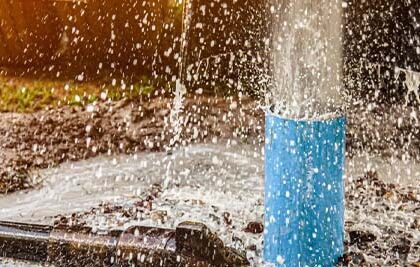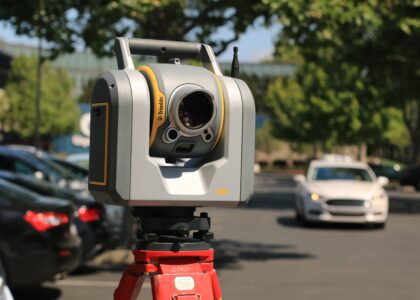Water is a fundamental human need, for “water is life.” To ensure that access to safe clean water is brought close to the people, governments and other actors invest in water supply systems (abstraction, treatment, pumping and distribution). These systems’ primary objective is to deliver all the water pumped into the distribution network to the end-user (consumer).
However, it is important to note, like in all systems, there are losses along the pumping-storage-distribution networks. Specifically for water supply systems, the collective name given to these losses is known as Non-Revenue Water.
Non-Revenue Water (NRW) is defined as the difference in quantities of water pumped or introduced into the water distribution systems (case of gravity sources) with the sum of all the water registered by all consumer water meters supplied by that water supply system or all the water billed for that particular month.
What do we mean when we talk about water loss?
Water loss is often referred to as non-revenue water (NRW) – water that is produced in a network but never reaches the consumer. This might be due to ageing networks which haven’t been properly managed, metering inaccuracies, theft or unmetered authorised consumption, like water used from fire hydrants.
NRW is in other words that quantity of water from which economic benefit is not derived.
In addition to economic factors, there are environmental issues, public health concerns, and requirements in regulations that warrant better management and more effective reduction of water leakage. Controlling network water losses helps curtail drops in water pressure and the associated risk of contamination.
Under our NRW and water loss management solutions, we offer multipronged solutions to address these shortcomings. We deploy high-end NRW equipment and water leak detectors, to accurately detect leaks on any underground water transmission pipes, thus enabling utilities to keep leakage volumes to levels that are acceptable and economically viable (Affordable losses).
We offer technical consultancy aimed to address network losses, leakage detection, network leakage monitoring, billing abnormalities, and water meter management. We offer a complete water loss management plan that involves 4 stages. Firstly, we undertake thorough water audits to ascertain the nature of non-revenue water loss. Secondly, we undertake active location and repair of leaks on water mains and primary distribution pipes. Thirdly, we offer technical advisory on pressure management (based on determination of key locations in the water distribution system that are subject to excessive applied pressure and hence subject to potentially higher levels of leakage, hence advice on installation of pressure reducing valves at such points). Finally, our water audit reports inform infrastructure management such as repair, replacement of water mains, and pumping stations, if very prone to breaks and leaks, and in case such replacement enables cost effective performance of the entire system. From our NRW assessment and water audits, we offer water loss management and reduction plans, advisory on improvement of metering, billing, and collection efficiency, establishment of economic levels of leakage (ELL), pressure reduction and management, analysis and improvement of operations and maintenance, technical trainings and supply of modern NRW technology,
We also implement such methods as District Metering Areas (DMAs) planning for easy monitoring and tracking of NRW owing to easy analysis of a particular command area, point of leak detection systems, to accurately locate and repair leaks. We deploy non-destructive testing (NDT) technologies to easily locate leakages and bursts on water transmission pipelines such as ground penetrating radars, sonar, and acoustic leak detectors, enabling utilities to reduce NRW to economic leakage levels, generally below 15%. Our interventions enable utilities effectively identify non-revenue water and devise opportunities to recover uncaptured revenue.
Our expert leak detection crews are equipped with proven leak detection tool kits, consisting of acoustic correlators, ground microphones, and noise loggers. This kit allows us to comprehensively survey the water network from above ground. The technology enables faster and more accurate leak detection, which, in turn, helps utilities to better serve their customers, meet legislative and environmental goals and requirements, and ultimately reduce Non-Revenue Water. Additionally, with detailed knowledge of potential leaks and the overall condition of the distribution network, lower operational costs can be expected, and utilities are better able to prioritise investments in maintenance, renovation or even additional capacity.
The technology gives utilities a real-time picture of the condition of their network and lets them easily identify high-risk installations where elevated noise levels indicate possible leaks or bursts. With our next-generation acoustic leak detection technology, potential leaks can be identified proactively before they become larger-scale issues.
Non revenue water arises due to:
- Meters under registration i.e., inaccurate meters not registering accurately.
- Faulty/defective meters i.e., non-readable and non-working meters.
- Meter tampering.
- Meter reversal.
- Meter bypass and illegal connections (Unauthorised consumption).
- Billing inaccuracies/errors.
- Pressure transients, changing flow rates passing through the water meter, and intermittent water supply in the network.
- Underbilling.
- Pirated connections.
- Leakages, bursts, infiltration, seepages, spills, tank overflows, etc.
- Unregistered and unbilled accounts.
Leakages cause numerous challenges such as:
- Water quality deterioration and health issues.
- Inequitable distribution within a network.
- Increased mains and service connection failures.
- Causes intermittent water supply due to pressure fluctuations. This further leads to water meter malfunctioning and accelerated wear and tear.
- Ineffective supply and demand management.
- Inefficient operations and need for more manpower to locate and fix leakages.
- High coping costs for customers i.e., installation of reservoir tanks, pumps, etc.
- Low revenue collections for the water purveyor/water utility.
Leakage monitoring helps achieve numerous benefits such as:
- Improving water asset management and addressing specific repairs that are needed.
- Maintain consistent water quality.
- Reduce customer complaints.
- Lower operational costs.
- Comply with WHO and applicable national drinking water supply standards.
- Lower operational costs.
- Preserve dissolved oxygen.
- Improve public health.
- Reduce non revenue water.
- Identify leaks, manage repairs, and effect proactive repairs.
- Prioritise repairs and replacements.
- Optimise capital plans i.e., ageing infrastructure planning and capital improvement plans (CIPs).
- Mitigate failures.
- Reduce leak run time, reduce water loss, and improve water supply network efficiency.
- NRW reduction means increase in revenue for water utilities.
- Maximise network efficiencies.
- Increase in knowledge about utility assets.
- Timely and accurate reporting.
- Reduces risk of consequence of failure.
Under our water loss management program, we offer the following:
- Supply of acoustic leakage detection (ALD) equipment.
- NRW assessment and strategy design.
- Preparation of NRW reduction strategic master plans.
- Network zoning and DMA design.
- Pressure management.
- Asset management plans.
- Smart water networks i.e., remote leakage and pressure monitoring sensors.
- Meter testing i.e., ultrasonic meters.
- Preparation of water efficiency plans.
- Water audits, including current use practice and identification of wastage.
- Operations and maintenance plans.
- Water balance studies.
- Leak detection and repair of underground pipes, including updating of plans.
- Leak location and repair on consumer plumbing.
- Design and installation of water-saving devices.
- Design and implementation of pressure control devices.
- Consumer meter evaluation for accuracy.
- Flow and pressure measurements before and after corrective measures.
- Revenue enhancement: consumer meter analyses, meter revenue analyses, meter audits.
- System stabilisation, ensuring that entire reticulation networks remain pressurised 100% of the time.
- Condition surveys of meters and valves i.e., condition surveys, testing, and calibration of bulk and district water meters.
- Water system operations i.e., training of operations staff, operations and maintenance plans and manuals.
- Optimal zoning of water distribution systems i.e., review of DMA’s (district metered areas) and pressure zones, including supply zone isolation checks.
- Leakage management i.e., datalogging, site inspections of visible leaks, step testing of DMA’s, leak detection of buried leaks using leak noise correlators and geophones.
- Technical advice on innovative and cost-efficient network monitoring systems according to the individual framework conditions of your supply system.
- Technical training to increase the NRW know-how in your water utility or WaSH organisation by means of individual training programmes.
Rationale for water loss control programs.
Around the world an equivalent of about 39 billion dollars a year of non-billed water is lost, with a percentage of losses globally between 20 and 50%., Volumes that can be traced back to various factors, including certainly physical causes such as breakages or unauthorised consumption. To try to avoid such consequences, it is necessary to provide for the efficiency of the networks by protecting the system from pressures that can lead to accelerated ageing. While most water utilities install and maintain domestic water meters, in most utilities customer meters are replaced on a run-to-fail basis, since in many countries there is not yet a mandatory requirement to replace the water meters. As a consequence, residential water meters are quite old and inaccurate.
Water supply system management has to be based on a deep knowledge of its cost, of the network water and energy consumption and of the level of water losses. Every leakage control program has a water system balance as a common starting point.
The importance of leak detection is not limited to concerns about water scarcity alone. It also entails the financial stresses on water utility rates and budgets related to ageing infrastructure and the unfunded treatment costs for every wasted gallon. The double-edged sword of water loss is that, for every gallon lost, the utility receives zero income to pay for salaries or infrastructure maintenance. On top of that, it must still fund the energy and chemical costs to pump and treat it.
Payments for damages to private property as a result of water main breaks are another potential out-of-pocket cost. Insurance might cover certain amounts, but self-insurance and higher premiums for repeat occurrences can eventually exceed the cost of a leak detection investment.
Increased repair complexity for leaks that escalate in severity, potentially becoming sinkholes before being discovered, typically incurs elevated component and labour costs. In extreme cases, that can include heavy equipment rental, more extensive traffic control, and perhaps penalties for disrupting major traffic routes or critical infrastructure such as hospitals or schools. This is what merits investment into water loss control, to maintain leaks within globally accepted economic levels of leakage. It also helps utilities satisfy/comply with regulatory mandates for water conservation.
The multi-step water loss control involves the following steps:
- Perform a water audit, or water balance, to account for all metered and non-metered water use. A properly done water audit gives the information needed to calculate non-revenue losses.
- Do a component analysis to determine where failed pipes or inaccurate meters are located. Having good data allows identifying bad components and prioritising them for repair.
- Develop an intervention strategy for repairing leaks. Setting up district metering areas, or DMAs, is one intervention strategy that makes it easier to identify abnormal consumption. DMAs are hydraulically separated areas within a distribution system and a valuable tool for combating NRW. This typically involves the installation of some boundary valves and a master meter to measure the inflow to the area, then comparing the inflow to the total reading of the meters. In most cases, there is some preliminary work necessary to determine the accuracy of meters in that area. This provides a better understanding of the split between NRW due to leaks versus that due to meter inaccuracies.
In our NRW advisory and training, we undertake the following:
- We analyse your water losses and advise on proper non-revenue water management strategy using the most advanced software tools (water balance).
- We design and implement pressure management zones (PMZ) and district metered areas (DMA) and support leakage reduction by choosing appropriate leak detection technology and repair strategies.
- We support the optimisation of your failure documentation and failure statistics and develop an appropriate database for maintenance planning.
- We support utilities to operate at the optimum level for energy efficiency, pumping efficiency and pressure management, including the monitoring and elimination of pressure transients by high-speed continuous pressure transient measurement.
- We support the optimisation of pressure in your system reducing leakages, burst frequency and energy costs. We help you to implement advanced pressure management (PM), a fundamental activity for water loss reduction and improved asset management.
- We analyse the efficiency of your customers meters and assist you to define an economic replacement plan to increase revenue and improve your level of service.











